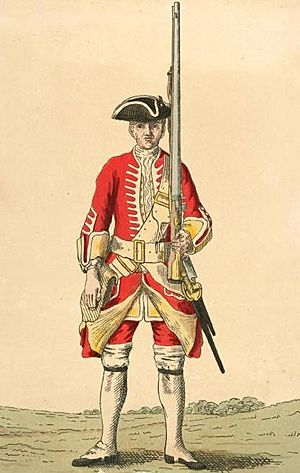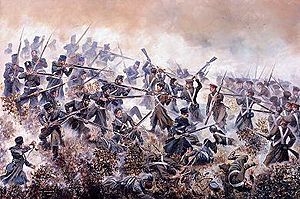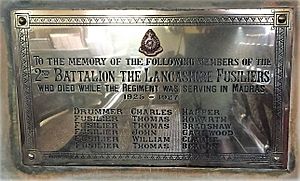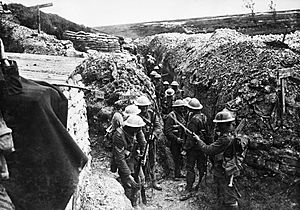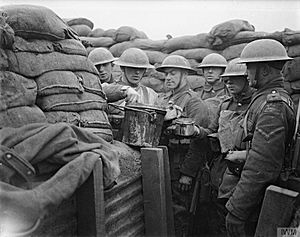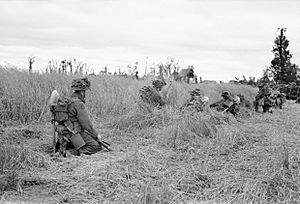Lancashire Fusiliers facts for kids
Quick facts for kids Peyton's Regiment of Foot20th Regiment of Foot 20th (East Devonshire) Regiment of Foot Lancashire Fusiliers |
|
|---|---|
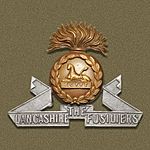
Cap badge of the Lancashire Fusiliers.
|
|
| Active | 1688–1968 |
| Country | |
| Branch | |
| Type | Line infantry |
| Role | Fusilier |
| Size | 1–2 Regular battalions 2 Militia and Special Reserve battalions 1–4 Territorial and Volunteer battalions Up to 24 Hostilities-only battalions |
| Garrison/HQ | Wellington Barracks, Bury |
| Nickname(s) | The Two Tens The Minden Boys Kingsley's Stand The Young Fusiliers |
| Motto(s) | Omnia audax |
| Anniversaries | Gallipoli (25 April) Minden (1 August) Inkerman (5 November) |
| Insignia | |
| Hackle | Primrose |
The Lancashire Fusiliers was a famous line infantry regiment of the British Army. This group of soldiers played an important part in many wars. These included the Second Boer War, the First World War, and the Second World War. Over its 280 years, the regiment had many different names. In 1968, the Lancashire Fusiliers joined together with other regiments. These were the Royal Northumberland Fusiliers, Royal Warwickshire Fusiliers, and the Royal Fusiliers (City of London Regiment). Together, they formed the Royal Regiment of Fusiliers that exists today.
Contents
History of the Lancashire Fusiliers
Early Years: 17th to 19th Century
How the Regiment Started (1688–1740)
The regiment began on 20 November 1688 in Torbay, Devon. It was first called Peyton's Regiment of Foot, named after its first leader, Sir Richard Peyton. For many years, the regiment's name changed with each new commanding colonel.
The soldiers served under King William III in the Glorious Revolution. They fought in the Battle of the Boyne in July 1690 and the Battle of Aughrim in 1691. During the War of the Spanish Succession (1701–1714), they helped capture Spanish ships at the Battle of Vigo Bay in 1702.
Battles Under New Leaders (1740–1746)
Under Thomas Bligh, the regiment showed great bravery at the Battle of Dettingen in June 1743. They also fought at the Battle of Fontenoy in May 1745. Later, led by Edward Cornwallis, the regiment served in the Battle of Culloden in April 1746. This battle was part of the Jacobite rising of 1745.
Becoming the 20th Regiment of Foot (1751–1782)
In 1751, the regiment got a permanent name: the 20th Regiment of Foot. People often wrote it as 'XX Foot', which led to their nickname The Two Tens.
During the Seven Years' War, the regiment earned great respect at the Battle of Minden on 1 August 1759. Here, as infantry soldiers, they bravely held their ground against a charging French cavalry attack.
Later, during the American Revolutionary War, the regiment went to Quebec in April 1776. They helped defend Quebec in May 1776. They served under General John Burgoyne and later surrendered with him at Saratoga.
The East Devonshire Connection (1782–1881)
In 1782, the regiment was renamed the 20th (East Devonshire) Regiment of Foot. They went to Holland in August 1799 for the Anglo-Russian invasion of Holland. They fought in the Battle of Krabbendam in September 1799 and the Battle of Alkmaar in October 1799.
Next, they went to Egypt in spring 1801. They saw action at the Battle of Alexandria in March 1801 during the French Revolutionary Wars. After moving to Calabria, they fought in the Battle of Maida in July 1806. This was during the War of the Third Coalition.
The regiment went to Portugal in 1808 for the Peninsular War. They fought at the Battle of Vimeiro in August 1808 and the Battle of Corunna in January 1809. They then returned home.
They came back to the Peninsula and fought bravely at the Battle of Vitoria in June 1813. Here, they were a key part of the Duke of Wellington's army. They then chased the French Army into France. They took part in the Battle of the Pyrenees in July 1813, the Battle of Nivelle in November 1813, and the Battle of Orthez in February 1814. They also fought in the Battle of Toulouse in April 1814.
During the Crimean War, the regiment fought in the Battle of Alma in September 1854 and the Battle of Inkerman in November 1854. A second group of soldiers, called the 2nd Battalion, was formed in 1858.
Becoming the Lancashire Fusiliers (1881–1908)
In 1881, the regiment officially became The Lancashire Fusiliers. Their main base was set up at Wellington Barracks, Bury in Bury. This meant they were now strongly linked to the Lancashire area.
The 2nd Battalion of the Lancashire Fusiliers was in British India from 1881 to 1898. They then joined Kitchener's campaign to take back Sudan and fought at the Battle of Omdurman. After a year in Malta, the battalion went to South Africa in December 1899. This was two months after the Second Boer War began.
During the Second Boer War, the 2nd Battalion fought at the Battle of Spion Kop in January 1900. They also helped in the Relief of Ladysmith in February 1900. The battalion stayed in South Africa until the war ended in June 1902.
The First World War (1914–1918)
Regular Army Battalions in WWI
The 1st Battalion was in Karachi at the start of the war. They returned to the UK in January 1915. They were very important in the landing at Cape Helles on 25 April 1915, during the Gallipoli Campaign. As the first boats landed, Ottoman soldiers fired at them, causing many injuries. Six Victoria Crosses, the highest award for bravery, were given to the 1st Battalion, Lancashire Fusiliers. This event became known as 'the six VCs before breakfast'. The landing spot was later called 'Lancashire Landing'. The battalion left Gallipoli in January 1916 and went to Marseille in March 1916. They then fought on the Western Front.
The 2nd Battalion arrived in Boulogne in August 1914. They also fought on the Western Front.
Territorial Force Battalions in WWI
Many other battalions of the Lancashire Fusiliers were formed during the war. These included the 1/5th, 1/6th, 1/7th, and 1/8th Battalions. They all landed at Cape Helles in early May 1915 and fought in the Second Battle of Krithia. They were evacuated from Gallipoli in December 1915. After a stop in Egypt, they moved to France in February 1917 to serve on the Western Front.

Other battalions, like the 2/5th, 2/6th, 2/7th, and 2/8th Battalions, also served on the Western Front. After heavy losses in March 1918, some units were used to train new US Army soldiers.
New Army Battalions in WWI
The 9th (Service) Battalion landed at Suvla Bay on the night of 6/7 August 1915. They faced heavy fire and lost their commanding officer. They left Gallipoli in December 1915, went to Egypt, and then to France in July 1916 to fight on the Western Front.
The 10th (Service) Battalion arrived in Boulogne in July 1915 and served on the Western Front. The 11th (Service) Battalion landed in Boulogne in September 1915. The famous fantasy author J. R. R. Tolkien served with this battalion until he got sick during the Battle of the Somme in October 1916.
Other battalions, like the 12th, 15th, 16th, 17th, 18th, 19th, and 20th (Service) Battalions, also served in various locations, including Salonika and the Western Front.
War Memorial
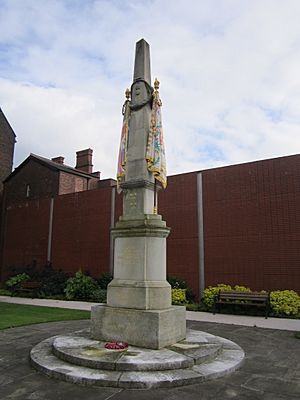
A special memorial was built in Bury to honor the soldiers who died in the First World War. It was designed by Sir Edwin Lutyens, who also designed the Cenotaph in London. The memorial was moved to Gallipoli Garden in Bury. After the regiment joined the Royal Regiment of Fusiliers, the memorial was rededicated to all fusiliers who died serving their country.
The Second World War (1939–1945)
Regular Army Battalions in WWII
After the First World War, the 1st Battalion, Lancashire Fusiliers, was stationed in different parts of the British Empire. When the Second World War started in 1939, they were in British India. During the Burma Campaign, the 1st Battalion fought in many battles. In 1943, they became part of the Chindits, a special force led by Brigadier Orde Wingate. The battalion took part in two major Chindit operations, suffering many losses.
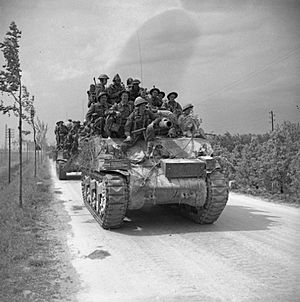
From 1939 to 1940, the 2nd Battalion, Lancashire Fusiliers, was part of the British Expeditionary Force (BEF). They fought against the German Army in Belgium and France. They were forced to retreat to Dunkirk and were evacuated back to the United Kingdom.
In June 1942, the 2nd Lancashire Fusiliers joined the new 78th Infantry Division. They then served in the North African Campaign, the Tunisian Campaign, Sicily, and the Italian Campaign. During the fighting in Italy, Fusilier Frank Jefferson was awarded the Victoria Cross for his bravery.
Territorial Army Battalions in WWII
The 1/5th Battalion was a Territorial Army (TA) unit. They went to France in April 1940 with the BEF and fought in the Battle of Dunkirk. They were also evacuated to Britain. In 1941, this battalion was changed to an armored unit, becoming the 108th Regiment Royal Armoured Corps (Lancashire Fusiliers).
The 1/6th Battalion also served in France in 1940 and was driven back to Dunkirk. In 1941, it also became an armored unit, the 109th Regiment Royal Armoured Corps.
The 1/8th Battalion also started the war in France with the BEF. During the Battle of France, the 1/8th Lancashire Fusiliers faced advancing German troops. Later, the battalion fought in the Burma Campaign and took part in famous battles like the Battle of Kohima. They served in the British Fourteenth Army.
The 2/5th Battalion, Lancashire Fusiliers, was formed in 1939. They landed in Normandy on 29 June 1944 as part of Operation Overlord. They first saw action in early July near Caen, where they suffered many casualties. They also fought in Operation Pomegranate and battles on the Orne River.
On 21 August 1944, the 59th Division, which the 2/5th Battalion was part of, was disbanded. This was because there was a severe shortage of infantry soldiers. The battalion's companies were sent to other British units. The Battalion War Diary called it "A sad day. 5 years of training for 8 weeks fighting."
The 2/6th Battalion, Lancashire Fusiliers, also served in the UK throughout the war, mainly in a training role. The 2/8th Battalion was also formed as a duplicate unit but remained in the United Kingdom and was disbanded in October 1944.
After 1945
Regular Battalions Reduced
In 1948, most British Army infantry regiments were reduced to just one regular battalion. The 2nd Battalion was disbanded and joined with the 1st Battalion. In 1968, the Regiment joined with other Fusilier regiments to form the Royal Regiment of Fusiliers.
Territorial Battalions Changed
The 5th Battalion was reformed but later disbanded in 1967. Other TA battalions became anti-aircraft (AA) units in Anti-Aircraft Command. For example, the 7th and 8th Battalions became parts of new AA regiments. These units defended against air attacks.
AA Command was disbanded in 1955. Many TA air defense units were disbanded or merged. The 7th and 8th Battalions, which had separate histories, were brought back together in a new regiment.
Regimental Museum
A collection of military items and educational displays about the Lancashire Fusiliers can be found at the Fusilier Museum in Bury.
Battle Honours
The regiment earned many battle honours, which are awards for bravery in specific battles. Some of these include:
- Dettingen, Minden, Egypt, Maida, Vimiera, Corunna, Vittoria, Pyrenees, Orthes, Toulouse, Peninsula, Alma, Inkerman, Sevastopol, Lucknow, Khartoum, Relief of Ladysmith, South Africa 1899–1902.
- Great War: Le Cateau, Marne 1914, Ypres 1915 '17 '18, Somme 1916 '18, Arras 1917 '18, Messines 1917, Passchendaele, Cambrai 1917 '18, St. Quentin, France and Flanders 1914–18, Gallipoli 1915, Egypt 1915–17.
- Second World War: Defence of Escaut, Caen, North-West Europe 1940 '44, North Africa 1942–43, Sicily 1943, Italy 1943–45, Malta 1941–42, Kohima, Burma 1943–45.
Victoria Cross Recipients
The Victoria Cross (VC) is the highest military award for bravery in the British armed forces. The following members of the Lancashire Fusiliers received this award:
- Captain (Temporary Major) Cuthbert Bromley, Great War
- Sergeant Frank Edward Stubbs, Great War
- Lance-Corporal (later Lieutenant-Colonel) John Elisha Grimshaw, Great War
- Captain (later Major) Richard Raymond Willis, Great War
- Sergeant Alfred Joseph Richards, Great War
- Private (later Lance-Sergeant) William Stephen Kenealy, Great War
- Private John Lynn, Great War
- Private (later Corporal) James Hutchinson, Great War
- Captain (Temporary Lieutenant-Colonel) Bertram Best-Dunkley, Great War
- Sergeant Joseph Lister, Great War
- Second Lieutenant Bernard Matthew Cassidy, Great War
- Temporary Second Lieutenant John Schofield, Great War
- Lance-Corporal Joel Halliwell, Great War
- Lance-Sergeant (later Lieutenant) Edward Benn Smith, Great War
- Acting Sergeant Harold John Colley, Great War
- Private Frank Lester, Great War
- Sergeant (later Regimental Sergeant-Major) James Clarke, Great War
- Acting Lieutenant-Colonel James Neville Marshall, Great War
- Fusilier (later Lance-Corporal) Francis Arthur Jefferson, Second World War
Colonels of the Regiment
The Colonel of the Regiment is a special honorary role. Here are some of the important leaders who held this position:
- 1688–1689: Col. Sir Robert Peyton
- 1689–1706: Maj-Gen. Gustavus Hamilton, 1st Viscount Boyne
- 1706–1714: Maj-Gen. John Newton
- 1714–1719: Lt-Gen. Thomas Meredyth
- 1719–1732: Col. Hon. William Egerton
- 1732–1737: Brig-Gen. Francis Howard, 1st Earl of Effingham
- 1737–1740: Lt-Gen. Richard St. George
- 1740: Col. Alexander Rose
- 1740–1746: Lt-Gen. Thomas Bligh
- 1746–1749: Lt-Gen. George Germain, 1st Viscount Sackville
- 1749–1755: Lt-Gen. George Keppel, 3rd Earl of Albemarle, KG (Viscount Bury)
Colonels of the 20th Regiment of Foot
- 1755–1756: Gen. Philip Honeywood
- 1756–1769: Lt-Gen. William Kingsley
- 1769–1773: Gen. Bernard Hale
- 1773–1782: Lt-Gen. Hon. George Lane Parker
Colonels of the 20th (East Devon) Regiment of Foot
- 1782–1789: Lt-Gen. William Wynyard
- 1789–1797: Lt-Gen. West Hyde
- 1797–1809: Gen. Charles Leigh
- 1809–1815: Lt-Gen Sir John Stuart, Count of Maida GCB
- 1815–1842: Gen Sir William Houston, 1st Baronet GCB GCH
- 1842–1850: Lt-Gen. Sir James Stevenson Burns KCB
- 1850–1853: Lt-Gen. Sir Andrew Pilkington, KCB
- 1853: Lt-Gen. Sir William Chalmers, CB, KCH
- 1853: Maj-Gen. Henry Godwin, CB
- 1853–1854: Lt-Gen. Sir Nathaniel Thorn, KCB, KH
- 1854-1858: Lt-Gen. Henry Thomas, CB
- 1858–1876: Gen. Marcus Beresford
- 1876–1894: Gen. Sir Frederick Horn, GCB
Colonels of the Lancashire Fusiliers
- 1894–1897: Gen. Sir William Pollexfen Radcliffe, KCB
- 1897–1909: Gen. Sir Edward Alan Holdich, GCB
- 1909–1914: Maj-Gen. Sir William Drummond Scrase-Dickins, KCB
- 1914–1926: Maj-Gen. Charles James Blomfield, CB, DSO
- 1926–1945: Maj-Gen. George Henry Basil Freeth, CB, CMG, DSO
- 1945–1955: Maj-Gen. George Surtees, CB, CBE, MC
- 1955–1965: Brig. Percy Geoffrey Bamford, CBE, DSO
- 1965–1968: Lt-Gen. Sir George Harris Lea, KCB, DSO, MBE
- 1968: Regiment joined with The Royal Northumberland Fusiliers, The Royal Warwickshire Fusiliers, and The Royal Fusiliers (City of London Regiment), to form The Royal Regiment of Fusiliers
Football Team
The football team of the 1st Battalion was part of the Irish Football League in the 1891-92 season. This was when they were stationed in Victoria Barracks, Belfast. They also won the Army Cup in 1896-97 while in Custume Barracks, Athlone.


